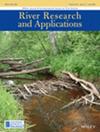水力发电的热量变化:模拟对幼年鲑鱼生长的影响
IF 1.9
4区 环境科学与生态学
Q4 ENVIRONMENTAL SCIENCES
引用次数: 0
摘要
上世纪,水力发电(HP)已成为全球最重要的可再生能源。然而,它对水生生态系统的影响可能相当大。在北半球,鲑科鱼类经常受到水电相关温度变化的影响。由于鲑科鱼类的新陈代谢过程完全依赖于水温,因此当水电开发在夏季从上游水库的温跃层以下抽取水以降低水温时,鲑科鱼类会受到严重影响。我们调查了挪威六条河流中大西洋鲑和褐鳟的幼鱼生长情况,这些河流的夏季水温因水力发电而大大降低。我们利用在水电站尾水渠上游和下游采样观察到的 1+ 幼鱼质量,并将其与根据每日记录的水温和生物能模型模拟的 1+ 幼鱼质量进行比较。水库的建立导致惠普水电站尾水渠下游河段两种鱼类幼体的生长速度减慢。水电开发极大地改变了温度机制,下游河段的温度低于上游河段。两种鱼类 1+ 幼体的观察质量和预测质量也都是下游低于上游。与褐鳟相比,大西洋鲑的预测质量与观测质量更为接近,这表明褐鳟的生物能模型并不理想。本文章由计算机程序翻译,如有差异,请以英文原文为准。
Thermal alterations of hydro power: Modelling the effect on growth of juvenile salmonids
Hydropower (HP) has become the most important renewable energy source worldwide during the last century. However, the impacts on aquatic ecosystems may be considerable. In the Northern Hemisphere, salmonid fishes are often affected by hydropower‐related temperature alterations. As their metabolic processes are entirely dependent on water temperature, they are strongly affected when the HP development reduces the water temperature during summer by extracting water from below the thermocline of upstream reservoirs. We investigated juvenile growth of Atlantic salmon Salmo salar and brown trout S. trutta in six Norwegian rivers where hydropower has considerably reduced the water temperature during summer. We used observed mass of 1+ juveniles sampled upstream and downstream the tailrace of the hydropower plant and compared these with simulated mass of 1+ juveniles based on daily recorded water temperatures and a bioenergetics model. Establishment of reservoirs have led to reduced growth of juveniles of both species on river reaches downstream HP tailraces. The hydropower development significantly altered the temperature regimes with the downstream reaches having lower temperatures than upstream reaches. Both observed and predicted masses of 1+ juveniles of both species were also lower downstream than upstream. Predicted mass were more similar to the observed mass for Atlantic salmon than for brown trout, indicating that the bioenergetics model for brown trout is not optimal.
求助全文
通过发布文献求助,成功后即可免费获取论文全文。
去求助
来源期刊

River Research and Applications
环境科学-环境科学
CiteScore
4.60
自引率
9.10%
发文量
158
审稿时长
6 months
期刊介绍:
River Research and Applications , previously published as Regulated Rivers: Research and Management (1987-2001), is an international journal dedicated to the promotion of basic and applied scientific research on rivers. The journal publishes original scientific and technical papers on biological, ecological, geomorphological, hydrological, engineering and geographical aspects related to rivers in both the developed and developing world. Papers showing how basic studies and new science can be of use in applied problems associated with river management, regulation and restoration are encouraged as is interdisciplinary research concerned directly or indirectly with river management problems.
 求助内容:
求助内容: 应助结果提醒方式:
应助结果提醒方式:


